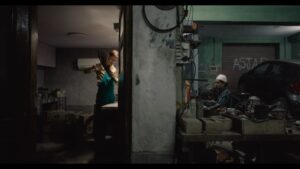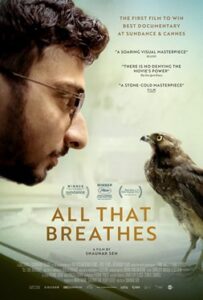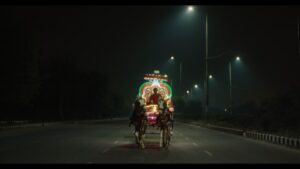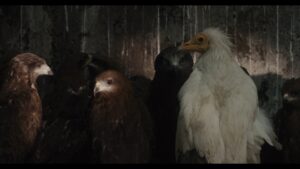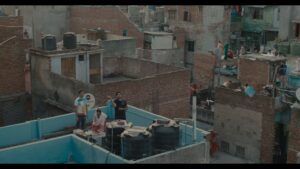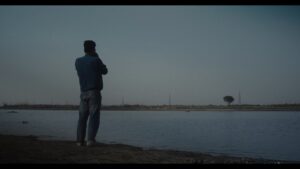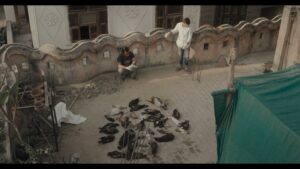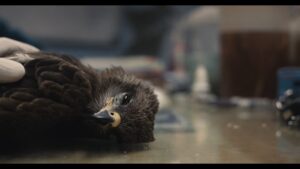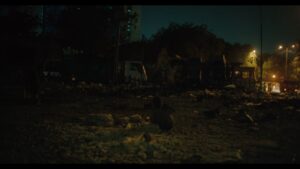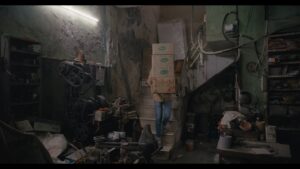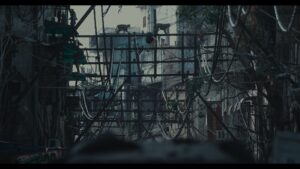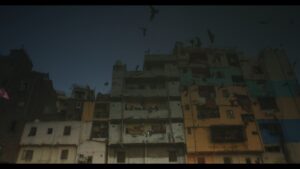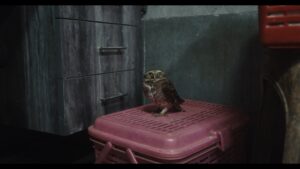Like a great many documentary-loving cinema buffs, I’m frequently critical of the “talking head” format. That would be your standard news interview format of sitting some people down in chairs and filming their informative faces as they go on at length and impart facts to the audience. I don’t mean to lay into the entire idea of filming an interviewee talking. For one thing, there’s always the case of an astonishing film like Errol Morris’ “The Fog of War”, where just watching a human being react, emote, think out loud and speak is the whole appeal. And even a more boundary-breaking documentary like John Oppenheimer’s “The Act of Killing” makes brilliant use of talking heads elements to supplement its more formally dynamic parts. I come not to bury talking heads but maybe to continue my push for limiting them. For making them more spice than steak. Some of the most astonishing documentaries from the last decade have been purely experiential (“Leviathan”, “Manakamana”), eschewing interviews and explanations entirely. “Now, now,” the talking head devil’s advocate on my left shoulder cautions. “Those films were designed to be immediate and sensory. A documentary aiming to shed light on a little-known subject in an
educational way is naturally going to need more learned, professorial figures explaining things to you. The little imp has a point. And yet, the question should always be how we can make films better. And on that note, I am proud to introduce Shaunek Sen’s “All That Breathes”, a film chock full experts with factoids to unload about nature and pollution and modern-day India that nonetheless manages to inform while always feeling like a cinematic experience. It takes the building blocks of a talking head documentary and alchemizes them into visual poetry. Here is a film that absolutely could have consisted largely of its main subjects (three altruistic brothers in Delhi who run a makeshift hospital for injured birds of prey) sitting in front of a camera and telling us their story. And the miraculous thing is that they do tell us their story and they do sometimes directly address the audience. And yet, the film nevewr breaks its enchanting, wondrously visual spell. Here is the surest proof yet that, while the talking head format may always have some role to play, we’re never had less need of its conventions. The documentary is officially free to spread its wings and fly.
“All That Breathes” cues us in early that it will be as much a film about reflecting on the wonder of nature as it will be an essay on present-day threats to the natural world. Whole minutes before we first hear the voices of our lovable bird saviors, we hear the sounds of a field somewhere amid the filthy streets of the Indian city of Delhi. There is the thick rustle of scavenging rodents, the drone of hovering insects and the barking of stray dogs. Cats mewl from the alleys. Sen’s brilliant cinematographers Ben Bernhard, Ritu Das and Saumyanada narrow in on a gathering of rats in a grassy lot. The ever-present Delhi traffic is out of focus, an afterthought. We will soon meet the brothers Mohmmad Saud and Nadeem Shenzad, and their soft-spoken friend Salik Rehman. We will see the inner workings of their makeshift miracle, a soap dispenser manufactury whose true purpose is the rescue, treatment and release of black kites, gorgeous, falcon-like birds of prey that are a beloved fixture
of Delhi’s skies. High pollution levels and other environmental challenges mean that more and more of these beautiful birds are plummeting from the sky and ending up in cardboard boxes in these men’s warehouse-cum-hospital. Like Oskar Schindler with his factory, the men use their soap dispenser business only for the unrelated good it can help them afford to do. The work is painstaking and sometimes heartbreaking but their renown in the community and the room full of rehabilitated birds waiting to soar again testifies to the noble value of their Sisyphean battle against climate change. At one point, as many as 28 injured black kites await medical treatment, and if that didn’t sound insurmountable enough, one brother explains, “The baby season hasn’t even started yet.” Sometimes this little family even puts itself at peril for their good work, as when two of the brothers ford a chilly river at dusk to bring a kite back from the precipice of death. In return, the kites not only spiritually enrich Delhi’s soul (caring for one is said to earn you goodwill from the gods) but serve a vital ecolofical function for the city. As Reza tells us, a single black kite can devour and erase an astounding five to six tons of waste in the span of ten months. The story of the rescuers’ evolution from aspiring bodybuilders (their interest in musculature aided their education as veterinarians) is moving and compelling enough on its own, but Sen and his team’s sense of keen observation and poetic tone makes “All That Breathes” nothing short of spell-binding. It feels like a stunning illuminated ode to making the world better. It’s by no means a tearjerker, but a fine, life-affirming mistiness hangs over the whole thing. This informational documentary about environmental healers has its own powerful, palpably therapeutic air.
We live in a world on the brink of some potentially disastrous changes, both on a natural and a societal scale, and “All That Breathes” never sells that fact short. It would have been easy for it to become a harrowing bearing of witness to environmental disaster, occassionally leavened by sweetness and human decency. The film also never ignores the futile frustration and fatigue that besets our heroes on a daily basis. But, with all that emotional exhaustion being something of the critical point of the film, “All That Breathes” still may be on of the least jaded or defeated movies I have ever seen. Much like its fellow 2022 documentary masterpiece
“All the Beauty and the Bloodshed”, “All That Breathes” is a tough, clear-eyed film buoyed by the contagious satisfaction of doing small acts of good in a weary world. With all of the year’s great writerly bits of dialogue, one of the most poignant and prescient moments consists of two simple words one man repeatedly says to another in that bird hospital. “Next bird.” As we stare down wrongdoing and loss, those two words better capture the joyous tenacity of carrying on than any I can think of. Good is done one step, one person, one bird at a time, and whether your last attempt to make life nicer on this planet succeeded or failed, your next move always boils down to just keeping the good work up. “All That Breathes” doesn’t pretend that we will just fix the environmental mess in front of us. It just sees
damage has been done and knows that the only wrong course is outright inaction and despondency. That won’t help. Like the kites chipping away at Delhi’s ne er-ending mountains of garbage. It’s there in the film’s care for the little representatives of nature. The way young Reza cares for a tiny squirrel he keeps in his shirt pocket. The way the film patiently watches a family of small monkeys cross a scaffolding on its way home. The documentary finds an endlessly soothing spring of calm because it reminds us how important and virtuous love and attention to the little things can be. Call it idealistic if you will, but the film’s belief that we will only win this survival game one selfless act and one individual at a time touched me greatly. If that tack feels simplistic in the face of rampant pollution, massive greed and unchecked selfishness, I cannot be too hard on this film for that. The value of small, simple goodness is the very lifeblood of “All That Breathes”.
Sen has made a great film about the impact of climate change because it is as informative on the subject as it needs to be and the rest is pure, voluptuous visual poetry. The shots of animals trying to habitate in one of Earth’s dirtiest, most populated cities speak volumes even devoid of the beautiful, thoughtful narration that accompanies them. There is something so stirring about how this isn’t just a tale of human expansion versus wild nature, but of human nature and wild nature juxtaposed. It is the story of nature adapting to a manmade world it never could have anticipated. As presented here, there is something simultaneously awe-inspiring and profoundly disquieting in its shots of graceful kites perched atop literal skyscrapers of human rubbish, or long-legged herons wading through streets flooded with soapy run-off. The situation that the natural world must negotiate because of human action and inaction is deeply unfortunate, but seeing how nature prevails in that struggle is stirring and visually breathtaking. Climate change is the most important and impactful issue of our day, and we need more films unpacking what it all means and how we can check its effects. But I will remember “All That Breathes” when a hundred climate change documentaries have come and gone because, in addition to being rigorous and eye-opening, it is just a transcendent, beautiful piece of cinematic art. It radiates poetry and takes inspiration from its protagonists’ contagious love of their work. It succeeds through jaw-dropping shots of man’s pollution and sprawl, and it also thrills with shots that luxuriate in the beauty and endless resilience of nature. It deserves to stand as a blueprint for how you tell stories about the climate crisis in fundamentally cinematic ways. “All That Breathes” is deeply rooted in the same Earth that it is advocating for. If the message of your movie is love of nature and stewardship of our planet, the first and best idea for making sure that message resonates is showing us a new view of that planet. If your film and its subjects are driven by love for the Earth, it doesn’t take a rocket scientist to know that your camera must make us fall in love with the Earth. This wondrous documentary also has a beautiful, detailed specificity to it. The climate crisis is vast and far from monolithic. It is happening in a hundred small, seismic ways, and these birds are just one of myriad portholes into this pressing issue. They are, in effect, the kite in the coal mine.
Visual imagination really makes all the difference in “All That Breathes”. I’ve well noted that. The overriding thesis of this whole review might as well be how the great documentaries do more than just function as information delivery systems. People need to do more than just learn and know. They need to remember, and they will remember if they are moved. I think we need to keep talking about the visual art of this film. Let me drive it home and say that “All That Breathes” has the best cinematography of 2022. In a year where Cinema went big and bold, where we plunged into sapphire fantasy oceans and leviathan jellyfish prowled the wide open skies; in a year where Steven Spielberg and Park-chan Wook made great new films; in such a year, this humane, whispered prayer of a documentary managed to give us more profoundly moving and lusciously composed shots than any other. Like another cinematography all-timer from 2022, Jerzy Skolimowski’s “EO” (which narrowly missed our top 20), Sen is subtly capturing animals in a strange way that feels utterly new to me. These shots of fauna feel intimate, confessional, almost invasive if it weren’t being done with such overflowing reverence. It somehow just sees animals in their singular, very immediate way. They are all completely themselves, which is to say, after centuries of anthropomorphism (can we admit that “March of the Penguins” is bad yet?), that animals are not us. We are us and the animals are what the animals are, and there is something poignant and environmentally wise in that truth and in that divide. The ravishing visual poetry of “All That Breathes” seems built around one humbling, powerful thesis: we have become distinct and different from the natural world and yet, we have never been above it or truly apart from it. At most, we forget that world, always at our own peril. In one ravishing shot, a group of activists protesting for Muslim tolerance gradually blurs into the background as we focus on a snail crawling along a twig in the foreground. “All That Breathes” sees a host of global struggles and it sees the space that separates them and the spiritual threads that invisibly bind them. As we fight vital battles for dignity and personhood, the natural struggle pushes forward as it has for millennia. “One shouldn’t differentiate between all that breathes,” one brother says in the line that gives this film its title. Sen’s masterful filmmaking team not only lucidly paints the world of this kite rescue operation, but vividly puts it into a language of magnetic images that take in all of nature. All struggles come down to the protection of lives. And “All That Breathes” renders each life onscreen with equal, even handed empathy.
Let me try briefly to come at the film from a very self-interested angle. All That Breathes is about finding the work that really defines you. These men may operate a soap dispensary business to fund their avian hospital, but what they’re really doing is earning for themselves the right to be thought of, first and foremost, as kite veterinarians. To see themselves and to be seen by their community as the thing they love doing. It’s a notion that speaks to this avocational, if not yet vocational, critic very deeply. When the eldest brother finds the financial freedom to receive a university education in the States, he does not go to learn better manufacturing practices nor to improve his business acumen. He goes to further his art, the thing he does that actually puts a piece of himself into the world. I am not being so bold as to suggest that me writing this glowing review of this wonderful movie is remotely as noble as what the kite rescuers are doing. But I like All That Breathes’ recognition, as the Mountain Goats’ great John Darnielle once sang, that “some things you do for money, and some you do for love, love, love.” It’s just another example of All That Breathes’ argument that the greater good is best served by what we do out of love and conviction. Maybe that’s naive but Sen is making a spiritual argument and the idea of belief in small, selfless changes feels spiritually true to his film. I’ve seen documentaries about conservation in exotic locales that mostly feel like excuses to satisfy the viewer with a nice human interest story (there was at least one such film in at least one of this Oscar’s documentary categories). But All That Breathes never feels like pat, self-satisfied progressive tourism. To me, it really does feel holy, which is just how these men see their work. It is an earnest call to conservation and a soaringly poetic ode to people doing good in the world and a most bewitchingly composed snapshot of the climate crisis. In a great film year full of rather unusual riches, just look at this empathetic little wonder. Behold: a documentary with the craft and passion to talk with more than just its head.